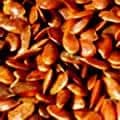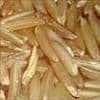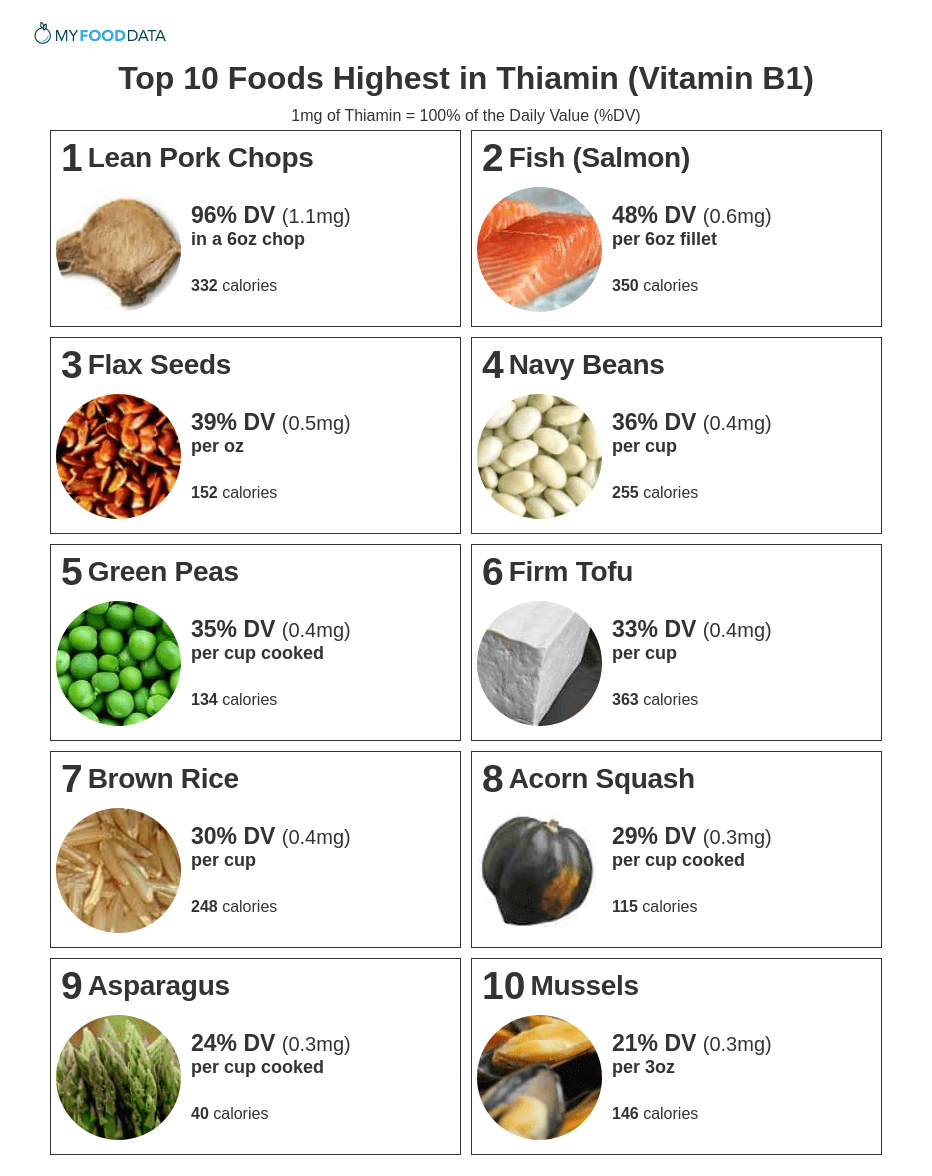Top 10 Foods Highest in Thiamin (Vitamin B1)

Thiamin (also known as thiamine or vitamin B1) is an essential nutrient required by the body for maintaining cellular function and metabolism. Consequently, it's crucial for the function of a wide array of organs, including the brain. (1)
While rare, a deficiency of thiamin leads to widespread degeneration of the body, particularly the nervous and circulatory systems. (2,3)
A deficiency of thiamin is known as beriberi. One specific type affects primarily the central nervous system, and is known as Wernicke-Korsakoff syndrome. Besides the nervous system, beriberi can also have a severe impact on the cardiovascular system, along with other body systems. (2) Worldwide, beriberi is most common in places where non-enriched white rice or other refined grains make up a large part of the diet. (3)
Over-consumption of thiamin is unknown and at least one study shows that amounts taken well in excess of the daily value (DV) may actually enhance brain functioning. (4) In fact, it appears that thiamin supplements may help to prevent Alzheimer's disease, although more research is needed in this area. (5,6)
Foods high in thiamin include pork, fish, seeds, nuts, beans, green peas, tofu, brown rice, squash, asparagus, and seafood. The current daily value (DV) for vitamin B1 is 1.2mg. (7)
Below is a list of high thiamin foods ranked by a common serving size. Use the nutrient ranking of all foods high in thiamin to sort by nutrient density (100-gram serving size).
Looking for more foods high in B Vitamins? Click here for other vitamin B foods.
List of High Thiamin Foods
 1 Lean Pork Chops
1 Lean Pork Chops| Thiamin in a 6oz Chop | Thiamin per 100g | Thiamin per 200 Calories |
|---|---|---|
| 1.1mg (96% DV) | 0.7mg (56% DV) | 0.7mg (58% DV) |
More Pork Products High in Thiamin
- 96% DV in 1 cup of cured ham
- 69% DV in 3oz of pork tenderloin
- 66% DV in 3oz of salami
See all meats high in thiamin.
 2 Fish (Salmon)
2 Fish (Salmon)| Thiamin per 6oz Fillet | Thiamin per 100g | Thiamin per 200 Calories |
|---|---|---|
| 0.6mg (48% DV) | 0.3mg (28% DV) | 0.3mg (28% DV) |
More Fish High in Thiamin
- 39% DV in a 6oz tuna fillet
- 33% DV in a 3oz trout fillet
- 27% DV in a 5oz catfish fillet
See all fish high in thiamin.
 3 Flax Seeds
3 Flax Seeds| Thiamin per Oz | Thiamin per 100g | Thiamin per 200 Calories |
|---|---|---|
| 0.5mg (39% DV) | 1.6mg (137% DV) | 0.6mg (51% DV) |
More Nuts and Seeds High in Thiamin
- 35% DV in 1oz of sunflower seeds
- 28% DV in 1oz of macadamia nuts
- 21% DV in 1oz of pistachios
See all nuts and seeds high in thiamin.
 4 Navy Beans
4 Navy Beans| Thiamin per Cup | Thiamin per 100g | Thiamin per 200 Calories |
|---|---|---|
| 0.4mg (36% DV) | 0.2mg (20% DV) | 0.3mg (28% DV) |
More Beans High in Thiamin
- 35% DV in 1 cup of black beans
- 29% DV in 1 cup of black-eyed peas
- 28% DV in 1 cup of lentils
See all beans high in thiamin.
 5 Green Peas
5 Green Peas| Thiamin per Cup Cooked | Thiamin per 100g | Thiamin per 200 Calories |
|---|---|---|
| 0.4mg (35% DV) | 0.3mg (22% DV) | 0.6mg (51% DV) |
See all vegetables high in thiamin.
 6 Firm Tofu
6 Firm Tofu| Thiamin per Cup | Thiamin per 100g | Thiamin per 200 Calories |
|---|---|---|
| 0.4mg (33% DV) | 0.2mg (13% DV) | 0.2mg (18% DV) |
More Soy Foods High in Thiamin
- 39% DV in 1 cup of cooked green soybeans
- 62% DV in a 16oz glass of soymilk
- 11% DV in 1 cup of tempeh
 7 Brown Rice
7 Brown Rice| Thiamin per Cup | Thiamin per 100g | Thiamin per 200 Calories |
|---|---|---|
| 0.4mg (30% DV) | 0.2mg (15% DV) | 0.3mg (24% DV) |
More Whole Grains High in Thiamin
- 21% DV in 2 slices of whole wheat bread
- 20% DV in 1 cup of cooked cornmeal (grits)
- 17% DV in 1 cup of quinoa
- 15% DV in 1 cup of oatmeal
See all grains high in thiamin.
 8 Acorn Squash
8 Acorn Squash| Thiamin per Cup Cooked | Thiamin per 100g | Thiamin per 200 Calories |
|---|---|---|
| 0.3mg (29% DV) | 0.2mg (14% DV) | 0.6mg (50% DV) |
See all vegetables high in thiamin.
 9 Asparagus
9 Asparagus| Thiamin per Cup Cooked | Thiamin per 100g | Thiamin per 200 Calories |
|---|---|---|
| 0.3mg (24% DV) | 0.2mg (14% DV) | 1.5mg (123% DV) |
See all vegetables high in thiamin.
 10 Mussels
10 Mussels| Thiamin per 3oz | Thiamin per 100g | Thiamin per 200 Calories |
|---|---|---|
| 0.3mg (21% DV) | 0.3mg (25% DV) | 0.3mg (29% DV) |
More Seafood High in Thiamin
- 24% DV in 20 small clams
- 16% DV in 3oz of abalone (sea snails)
- 9% DV in 3oz of oysters
Printable One Page Sheet

Thiamin (B1) Requirements By Age and Gender
The recommended daily allowance (RDA) for thiamin (Vitamin B1) ranges from 0.5mg to 1.4mg per day. The daily value for vitamin B1 is 1.2mg per day. (7)
| Life Stage | RDA |
|---|---|
| Infants* | |
| 0-6 months old | 0.2mg |
| 7-12 months old | 0.3mg |
| Children | |
| 1-3 years old | 0.5mg |
| 4-8 years old | 0.6mg |
| Males | |
| 9-13 years old | 0.9mg |
| 14-18 years old | 1.2mg |
| 19-50 years old | 1.2mg |
| 50+ years old | 1.2mg |
| Females | |
| 9-13 years old | 0.9mg |
| 14-18 years old | 1mg |
| 19-50 years old | 1.1mg |
| 50+ years old | 1.1mg |
| Pregnancy | |
| 14-18 years old | 1.4mg |
| 18+ years old | 1.4mg |
| Lactation | |
| 14-18 years old | 1.2mg |
| 18+ years old | 1.2mg |
Source: Dietary Reference Intakes for Thiamin.
Other Vitamin B Foods
About the Data
Data for the curated food lists comes from the USDA Food Data Central Repository.
You can check our data against the USDA by clicking the (Source) link at the bottom of each food listing.
Note: When checking data please be sure the serving sizes are the same. In the rare case you find any difference, please contact us and we will fix it right away.
About Nutrient Targets
Setting targets can provide a guide to healthy eating.
Some of the most popular targets include:- Daily Value (%DV) - The daily value (%DV) is a general guideline for consumption that will prevent deficiency of a particular nutrient in most people. The %DV refers to the percentage of an amount that's found in a single serving of a food. It also accounts for absorption factors. It is set by the U.S. FDA.
- Recommended Dietary Allowance (%RDA) - The RDA sets an average daily dietary intake level that is sufficient to meet the nutrient requirements of nearly all (97.5%) healthy individuals. It's more specific than the daily value, and varies by age and gender. The RDA is set by the US National Instutites of Health.
- Reference Dietary Intake (%RDI) -The reference dietary intake is similar to the recommended daily allowance, but is specific to age and gender. The RDI for amino acids is set by the U.N. World Health Organization.
- Adequate Intake (%AI) - This value is primarily used in reference to omega-3 and omega-6 fats. The Adequate Intake is set by the U.S. Institute of Medicine. Because there is less evidence to determine the ideal targets for consumption of these nutrients, the specific amount is considered to be less reliable. Using the term Adequate Intake, rather than one of the other terms, helps to emphasize that the ideal intake of that particular nutrient has not yet been scientifically determined.
See the Guide to Recommended Daily Intakes for more information.
Want to set your own targets? Sign up for an account and set custom targets in the daily meal planner.From the Nutrient Ranking Tool
Use the ranking tool links below to select foods and create your own food list to share or print.
- Foods High in Thiamin (B1)
- Foods Low in Thiamin (B1)
- Vegetables High in Thiamin (B1)
- Fruits High in Thiamin (B1)
- Vegetarian Foods High in Thiamin (B1)
- Nuts High in Thiamin (B1)
- Grains High in Thiamin (B1)
- Beans High in Thiamin (B1)
- Dairy High in Thiamin (B1)
- Breakfast Cereals High in Thiamin (B1)
- Fast Foods High in Thiamin (B1)
View more nutrients with the nutrient ranking tool, or see ratios with the nutrient ratio tool.
Related
Data Sources and References
- The importance of thiamine (vitamin B1) in humans
- Shible AA, Ramadurai D, Gergen D, Reynolds PM. Vitamin B1 (Thiamine) Deficiency Am J Case Rep. 2019 Mar 13;20:330-334. doi: 10.12659/AJCR.914051. 30862772
- Shible AA, Ramadurai D, Gergen D, Reynolds PM. Thiamine deficiency disorders: a clinical perspective Am J Case Rep. 2019 Mar 13;20:330-334. doi: 10.12659/AJCR.914051. 30862772
- Benton D, Fordy J, Haller J. Thiamine supplementation mood and cognitive functioning Psychopharmacology (Berl). 1995 Feb;117(3):298-305. doi: 10.1007/BF02246104. 7770605
- Chen Z, Zhong C. Supplemental thiamine as a practical, potential way to prevent Alzheimer's disease from commencing Prog Neurobiol. 2013 Sep;108:21-43. doi: 10.1016/j.pneurobio.2013.06.004. Epub 2013 Jul 11. 23850509
- Vignisse J, Sambon M, Gorlova A, Pavlov D, Caron N, Malgrange B, Shevtsova E, Svistunov A, Anthony DC, Markova N, Bazhenova N, Coumans B, Lakaye B, Wins P, Strekalova T, Bettendorff L. Neuroprotective Effects of Thiamine and Precursors with Higher Bioavailability: Focus on Benfotiamine and Dibenzoylthiamine Mol Cell Neurosci. 2017 Jul;82:126-136. doi: 10.1016/j.mcn.2017.05.005. Epub 2017 May 12. 28506637
- U.S.FDA - Daily Value on the New Nutrition and Supplement Facts Labels
- Office of Dietary Supplements on Thiamin
Try the recipe nutrition calculator, or daily meal planner.
Create a free account to log and track foods.

